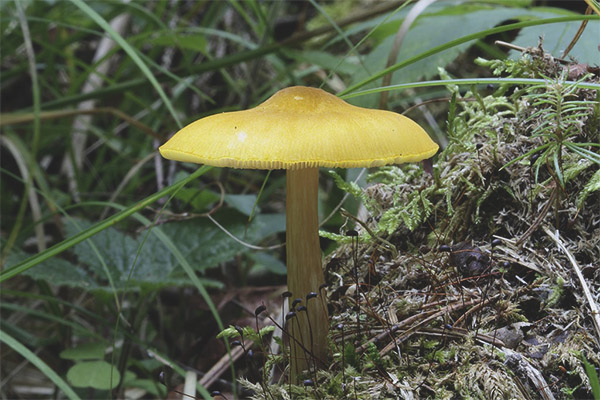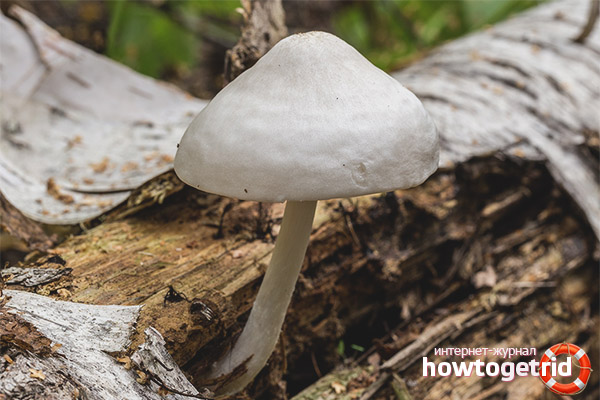The content of the article
Plyus is ranked among the Plyutev family, there are quite a lot of representatives, but today we will look at the lion-yellow. Growth is carried out on diseased or rotten trees. The spread is wide, so finding the next bright yellow inhabitant is not difficult in the forest belt. However, despite the vast area of growth and impressive external data, lovers of quiet hunting are not in a hurry to throw these fruit bodies to their basket. In today's material we will study everything that affects this species.
Description
- The tip of its diameter ranges from 6 cm. Maximum. Initially, its format resembles a bell, but then becomes flat with a smooth bulge. The hat is quite thin and hanging around the edges. She is matte with some velvety. But it can be smoothed and glossy, in the end, it all depends on the climatic conditions, the region of growth, as well as the weather conditions at a particular moment.
- The hat is pigmented in yellow with some brownish patches, although not always. Often you can find bright honey representatives with a predominant yellow color. In the central part there is a mound, which has a mesh-like pattern. The edges are ribbed, streaked. The plates are quite extensive, close to each other, freely hanging down. They are stained with yellow-white, becoming pinkish in old age.
- The base is thin and long, stretching to a height of 9 cm with a thickness of about 5 mm. Format as cylinder. An expansion is noted in the lower section, closer to the ground. The leg itself is curved, but it can be even and twisted. There are fibers on the base, color yellow or so. Brown shades or darkness may be noticed. The soft part is compacted and whitish, it smells good, tastes are weak. Spores of pinkish pigment.
- It makes sense to touch and edibility of the presented copies. Despite the fact that this fruit body is considered to be edible, the taste is not distinct, the mushroom itself is of poor quality. Before consumption and further cooking, a 15-minute digestion is carried out, then you can make twists, first / second courses, etc.Mushroom suitable for drying and salting.
Spread
- It has already been mentioned that these representatives of the mushroom family live in larches. They like to be located next to beech, oak, birch, aspen. It is very rare for mushroom pickers to find similar fruit bodies in the coniferous strip.
- By its natural features, the reduced fruit body is a saprophyte. Simply put, prefers to be located on dying trees, rotting bark, stumps. There are also mushrooms on the roots, sitting closer to the soil. It is extremely rare to settle on a living tree, but this is likely.
Noble plute
- Such fruit bodies belong to the group of inedible fungi. As for the fruiting period, the specimens are found in forests from mid-summer to mid-autumn. A noble sputum can see a white cap.
- In rare cases, it is colored gray or slightly yellow. The edges are down and at the same time they are smooth. Leg has a light color. In addition, in some fruit bodies, it may have a brownish coating.
- Such a mushroom can be found in the forests of the Russian Federation. As mentioned earlier, the cap of such specimens is colored brown or grayish. Moreover, in more mature mushrooms, its edges begin to bully upwards.
- Leg specimens glossy and painted in a light color. As for the records, they are not located close to each other. They are gray in color. The mushroom has a twin called a scaly-like spit. However, the latter size is smaller. Scales are expressed much stronger.
White plute
- Such a fruit body has a leg up to 12 cm high. At the same time, its thickness cannot exceed 2 cm. Inside it is not hollow, there are fibers and pulp. The color is completely white. The leg has a dense structure.
- The cap of such specimens in diameter grows up to 13 cm. At the same time, by its structure it is slightly fleshy and brittle. In young fruit bodies the cap has the shape of a hemisphere. With age, it gradually unfolds.
- The structure of the cap is fibrous and silky to the touch. The color is white, there are small scales on the surface. Young mushrooms have infrequent white plates. As for the pulp, it is soft and whitish.If you cut the fruit, the color will not change. The fragrance is almost absent.
Fruit bodies are suitable for food, but do not forget that these mushrooms are not famous for their high taste. When collecting data specimens, be careful not to confuse them with similar species and doubles.
Video: plute lion-yellow (Pluteus leoninus)












To send